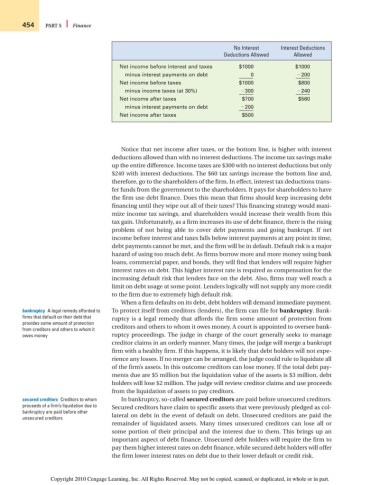Page 480 - Introduction to Business
P. 480
454 PART 5 Finance
No Interest Interest Deductions
Deductions Allowed Allowed
Net income before interest and taxes $1000 $1000
minus interest payments on debt 0 200
Net income before taxes $1000 $800
minus income taxes (at 30%) 300 240
Net income after taxes $700 $560
minus interest payments on debt 200
Net income after taxes $500
Notice that net income after taxes, or the bottom line, is higher with interest
deductions allowed than with no interest deductions. The income tax savings make
up the entire difference. Income taxes are $300 with no interest deductions but only
$240 with interest deductions. The $60 tax savings increase the bottom line and,
therefore, go to the shareholders of the firm. In effect, interest tax deductions trans-
fer funds from the government to the shareholders. It pays for shareholders to have
the firm use debt finance. Does this mean that firms should keep increasing debt
financing until they wipe out all of their taxes? This financing strategy would maxi-
mize income tax savings, and shareholders would increase their wealth from this
tax gain. Unfortunately, as a firm increases its use of debt finance, there is the rising
problem of not being able to cover debt payments and going bankrupt. If net
income before interest and taxes falls below interest payments at any point in time,
debt payments cannot be met, and the firm will be in default. Default risk is a major
hazard of using too much debt. As firms borrow more and more money using bank
loans, commercial paper, and bonds, they will find that lenders will require higher
interest rates on debt. This higher interest rate is required as compensation for the
increasing default risk that lenders face on the debt. Also, firms may well reach a
limit on debt usage at some point. Lenders logically will not supply any more credit
to the firm due to extremely high default risk.
When a firm defaults on its debt, debt holders will demand immediate payment.
bankruptcy A legal remedy afforded to To protect itself from creditors (lenders), the firm can file for bankruptcy. Bank-
firms that default on their debt that ruptcy is a legal remedy that affords the firm some amount of protection from
provides some amount of protection
from creditors and others to whom it creditors and others to whom it owes money. A court is appointed to oversee bank-
owes money ruptcy proceedings. The judge in charge of the court generally seeks to manage
creditor claims in an orderly manner. Many times, the judge will merge a bankrupt
firm with a healthy firm. If this happens, it is likely that debt holders will not expe-
rience any losses. If no merger can be arranged, the judge could rule to liquidate all
of the firm’s assets. In this outcome creditors can lose money. If the total debt pay-
ments due are $5 million but the liquidation value of the assets is $3 million, debt
holders will lose $2 million. The judge will review creditor claims and use proceeds
from the liquidation of assets to pay creditors.
secured creditors Creditors to whom In bankruptcy, so-called secured creditors are paid before unsecured creditors.
proceeds of a firm’s liquidation due to Secured creditors have claim to specific assets that were previously pledged as col-
bankruptcy are paid before other
unsecured creditors lateral on debt in the event of default on debt. Unsecured creditors are paid the
remainder of liquidated assets. Many times unsecured creditors can lose all or
some portion of their principal and the interest due to them. This brings up an
important aspect of debt finance. Unsecured debt holders will require the firm to
pay them higher interest rates on debt finance, while secured debt holders will offer
the firm lower interest rates on debt due to their lower default or credit risk.
Copyright 2010 Cengage Learning, Inc. All Rights Reserved. May not be copied, scanned, or duplicated, in whole or in part.

